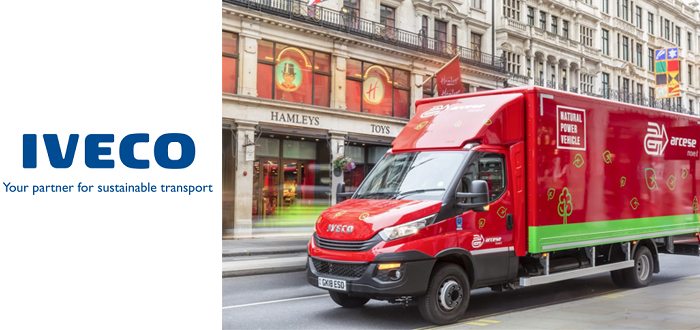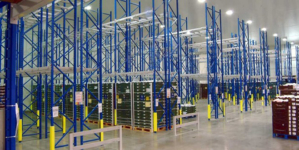-
ROSSLARE EUROPORT TARGETS HEALTH & SAFETY WITH CAMERA TELEMATICS PARTNERSHIP - 2 days ago
-
Landmark Study Reveals Wearable Robotics Significantly Boost Safety and Efficiency in Industrial Environments - July 24, 2024
-
Visku Tackle The Retail Seasonality Challenge One Pallet At A Time - July 22, 2024
-
KAMMAC AND BERGEN LOGISTICS STRENGTHEN FASHION & LIFESTYLE SERVICES IN THE UK - July 19, 2024
-
TENTBOX EXTENDS PARTNERSHIP WITH ARROWXL TO SUPPORT INCREASING DEMAND - July 17, 2024
-
The Perfume Shop improves customer journeys while driving profitability in partnership with Scurri - July 17, 2024
-
ZEROMISSION SECURES £2.3M ($3M) INVESTMENT TO ACCELERATE ELECTRIC FLEETS - July 16, 2024
-
BCMPA CELEBRATES SUCCESS OF 2024 CONFERENCE - July 15, 2024
-
Best of the Best: Jungheinrich Celebrates Triple International Award Win - July 12, 2024
-
GOPLASTICPALLETS.COM CALLS ON NEW CHANCELLOR RACHEL REEVES TO CONSIDER PLASTIC PACKAGING TAX REFORM - July 10, 2024
Believe the hype – and embrace it.
After a decade of ‘keep calm and carry on’ messaging, it is time for retailers to face up to the inevitable: innovate or die. While it is tempting to assume that many of the headline technology experiments by the likes of Amazon, eBay et al are more about publicity than profit, the fact is that the deep pockets of these retailers has transformed the pace of change – and off the wall today is likely to be in store – or online – tomorrow.
One of the most critical changes is a mindset shift from reactive to proactive retailing. From free delivery and returns onwards, over the past decade retailers have felt obliged to react to every customer demand in a bid to remain competitive. But what is the business cost of delivering these strategies? Is it justified by an uplift in sales? New technologies, from IoT to big data, voice search to chatbots, not only enable retailers to operate more effectively, to reach new customers, and achieve faster pick, pack and dispatch with fewer errors; critically they also provide the chance to be proactive, to influence customer behaviour.
Technology innovation is about retailers taking back control – before it is too late. As Mike Cockfield, Managing Director, Khaos Control, insists, retailers need to focus on intelligently targeted selling and that demands a slick combination of experimentation and innovation with robust near real time analytics to continually assess and understand performance.
Influencing Behaviour
Retail has changed fundamentally. It is no longer enough to do the basics well, to invest in great products, merchandise effectively and present a strong customer message: the confidence with which retailers now embrace technology now defines success.
Of course, there are a host of technology innovations that are just not ready for the mainstream. AI for chatbots and product recommendations still lack maturity, while Amazon’s Shop & Go and similar experiments – including a Drive Thru’ version in the Middle East – are great test beds for innovation including Augmented Reality (AR), but are certainly not yet ready for widespread deployment.
But these technologies are about delighting the customer, about appealing to millennials, experimenting with getting people back into a physical store and changing the engagement; and with the speed of innovation today, enabled by the deep pockets of the market leaders, if retailers are not actively tracking these technologies there is a huge risk of leaving it too late. The rest of the market needs to be ready; to have the foundation today that enables proactive retailing, transforming the way retailers operate and providing the insight required to support the experimentation that will increasingly underpin retail success.
Taking Control
This requires a mindset change, a willingness for example to not only capture the reason for a return – wrong size, mis-picked item, poor quality – but to use this information to drive change internally and within the customer base. For example, by embedding rules into the ERP system, an item returned due to quality concerns can be automatically be flagged for checking to determine whether or not it can be placed back on the shelf or returned to a supplier. Mis-picks can be tracked back to one particular individual and additional training provided to minimise this problem.
This information can also be used to support the customer experience. Analysing size issues, for example, may reveal a problem with one product group or supplier. While this insight should clearly
feed into merchandising processes, it may also be useful to improve the sizing information on the website to provide customers with a better chance of making the right choice, which should lead to fewer returns. Automated rules can also be used to prioritise delivery to specific customer groups based on lifetime value; or push out a half completed order after a set number of days, rather than wait for full restocking, to ensure customer expectations are met.
Efficient and Effective
Combining in depth analysis and understanding of the end to end pick, pack and dispatch process with research into trends in customer expectation and experience can enable retailers to reconsider strategies and determine opportunities to influence customer behaviour to both improve experience and drive up revenue.
What about addressing the cost of delivery? First-time-in-full delivery is the objective for every retailer and courier, not only to minimise costs but also improve customer experience. Whether the result of impossible parking or a lack of safe location for delivery, it can take multiple attempts to get products to some customers. In these instances, why not incentivise the customer to use an alternate location – such as click & collect or secure lockers?
With deep, fast insight into customers’ cycle of returns and purchase history, retailers can proactively tailor the offer and experience to minimise returns, improve first-time-in-full delivery, and delight the customer while still retaining complete control over the cost base.
Embrace Experimentation
Furthermore, this understanding also supports the rapid innovation and experimentation now required to remain in the retail game. Whether it is leveraging the new ease of ERP integration to add new channels to market anywhere in the world, ensuring SEO strategies support the sharp rise in visual and voice search, even trialling crowdsourced two-hour delivery options, the ability to analyse trends in sales and customer lifetime value provides retailers with an understanding of both the cost and the business value.
Given the sheer diversity of technology options, any small to medium sized organisation will be concerned about the risk of innovation, about damaging the customer experience or wasting money on ideas that don’t gain traction. It is essential to stay ahead of the wave by trying new things, from new channels to delivery models – but don’t lose sight of the customer in the process. This is never about technology for the sake of it.
From sales figures to delivery performance and customer lifetime value, by combining in depth understanding of the customer experience with a culture of innovation and experimentation, retailers can turn the tide, stop reacting to customer demands and achieve a proactive, profit driven retail model.
Believe the hype. Embrace it. And delight the customer.

































